3 Top Tips for Heating Your Home More Efficiently this Winter
As winter approaches, many homeowners are getting ready for the holiday season and turning on their heater for the first time. As you start to turn up the heat, it’s important to be aware of your energy use as it can start to drive your heating bills through the roof. The key to keeping heating costs down during the winter is taking the necessary steps to heat your home more efficiently.
Energy Saving Tips for Efficient Heating
Want to save money on heating costs this winter? We’ve put together a list of energy saving tips for heating your home more efficiently this winter:
-
Inspect and improve home insulation.
Poor insulation can allow heat to escape. When you waste energy, your electricity bills tend to skyrocket. It’s important to inspect your home insulation and check for drafts. Replace any damaged or missing weather-stripping around your doors and windows. Adjust any door thresholds to eliminate any gaps that may allow warm air to escape. Don’t forget to check your electrical boxes for drafts, and fill any gaps with latex caulk or foam sealant. A little work can go a long way when it comes to home insulation as even the tiniest leaks and cracks can make an impact on your heating costs.
-
Use a space heater when you can.
You can use a space heater to help reduce heating costs when your family is all together during the holidays. Place the heater in the area where your family is gathering, like the living room or den. Then, turn down the furnace temperature. Though the rest of your home will be cooler, this is a good solution for families that are spending a lot of time together in one area of the home during the holidays. According to the California Energy Commission, you can save 5% on energy costs by setting your thermostat to the 60- to 70-degree range. The space heater will still use electricity, but you can save a significant amount of energy by cutting down on your furnace use and utilizing a space heater when you can.
-
Tune up your furnace.
One of the best ways to save energy throughout the year is to ensure that your HVAC system is running as efficiently as possible. Make sure that you get your annual furnace or heater tune-up before the heating season starts. During this maintenance visit, an experienced HVAC technician will ensure that your heating system is clean, lubricated, and working properly. This increases energy efficiency and can help you save money on heating costs in the long run.
If you are ready to take the next step toward optimal efficiency, Schmitt Heating and Air Conditioning is ready to help you find a brand new, high-efficiency heating and air conditioning system. Contact us today to find out more about your options or to schedule a consultation with one of our heating and cooling experts.


